The Regulation of Monopolies: Economic Theories, Methods, and Impacts
VerifiedAdded on 2020/02/24
|12
|2241
|158
Essay
AI Summary
This essay provides an in-depth analysis of monopoly regulation, exploring the economic rationale for government intervention in markets dominated by single producers. It begins by defining monopolies and natural monopolies, highlighting their characteristics and potential for market inefficiencies. The essay then delves into the economic harms associated with unregulated monopolies, such as deadweight loss, and the motivations for regulation, including allocative efficiency and consumer welfare. Various regulatory methods are examined, including price ceilings, average cost pricing, marginal cost pricing, and differential tariffs, with their advantages and disadvantages discussed. The essay also considers the role of subsidies and government ownership as potential solutions. The conclusion emphasizes the importance of regulation in preventing monopolies from abusing their market power and ensuring economic efficiency. The essay references key economic theories and provides examples to support its arguments, offering a comprehensive overview of the topic.
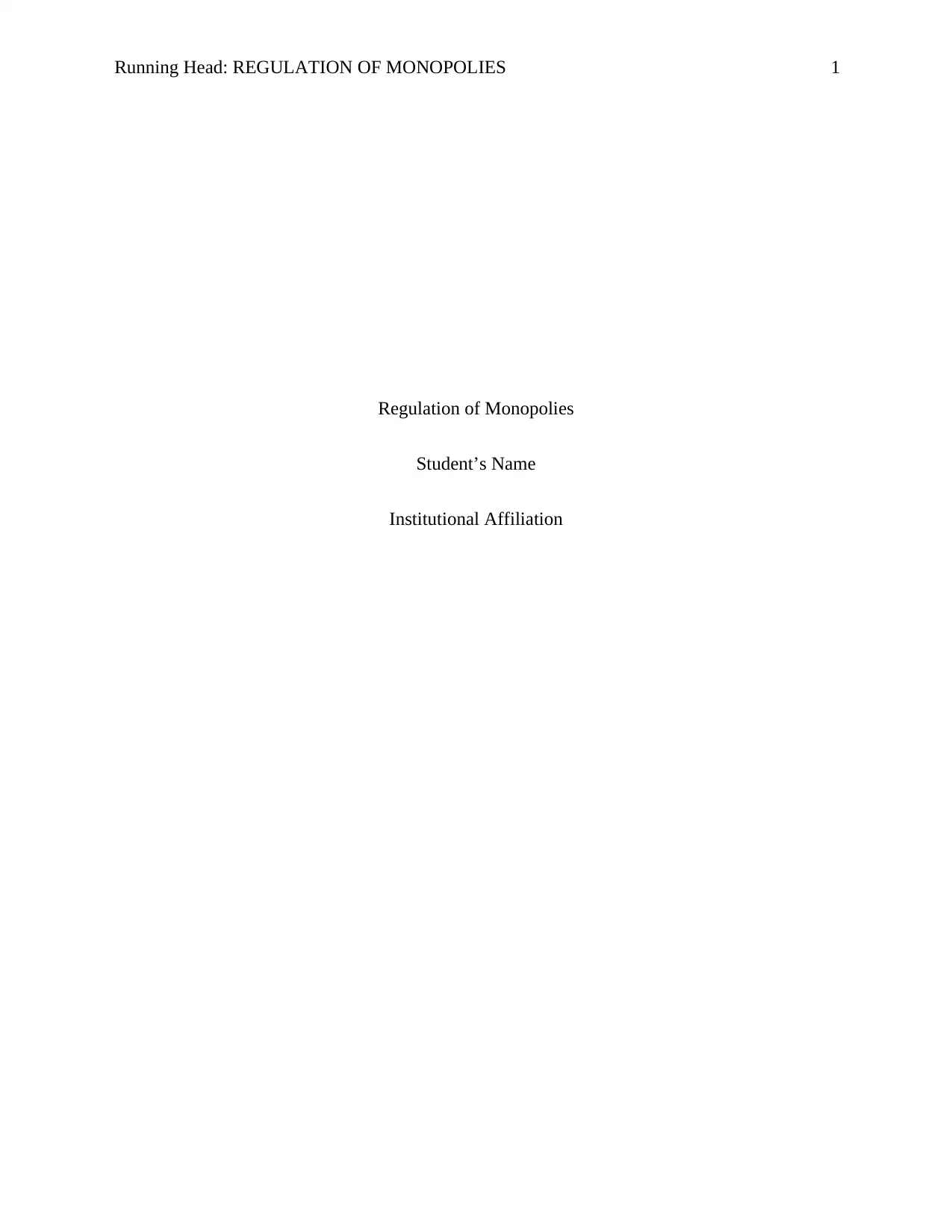
Running Head: REGULATION OF MONOPOLIES 1
Regulation of Monopolies
Student’s Name
Institutional Affiliation
Regulation of Monopolies
Student’s Name
Institutional Affiliation
Paraphrase This Document
Need a fresh take? Get an instant paraphrase of this document with our AI Paraphraser
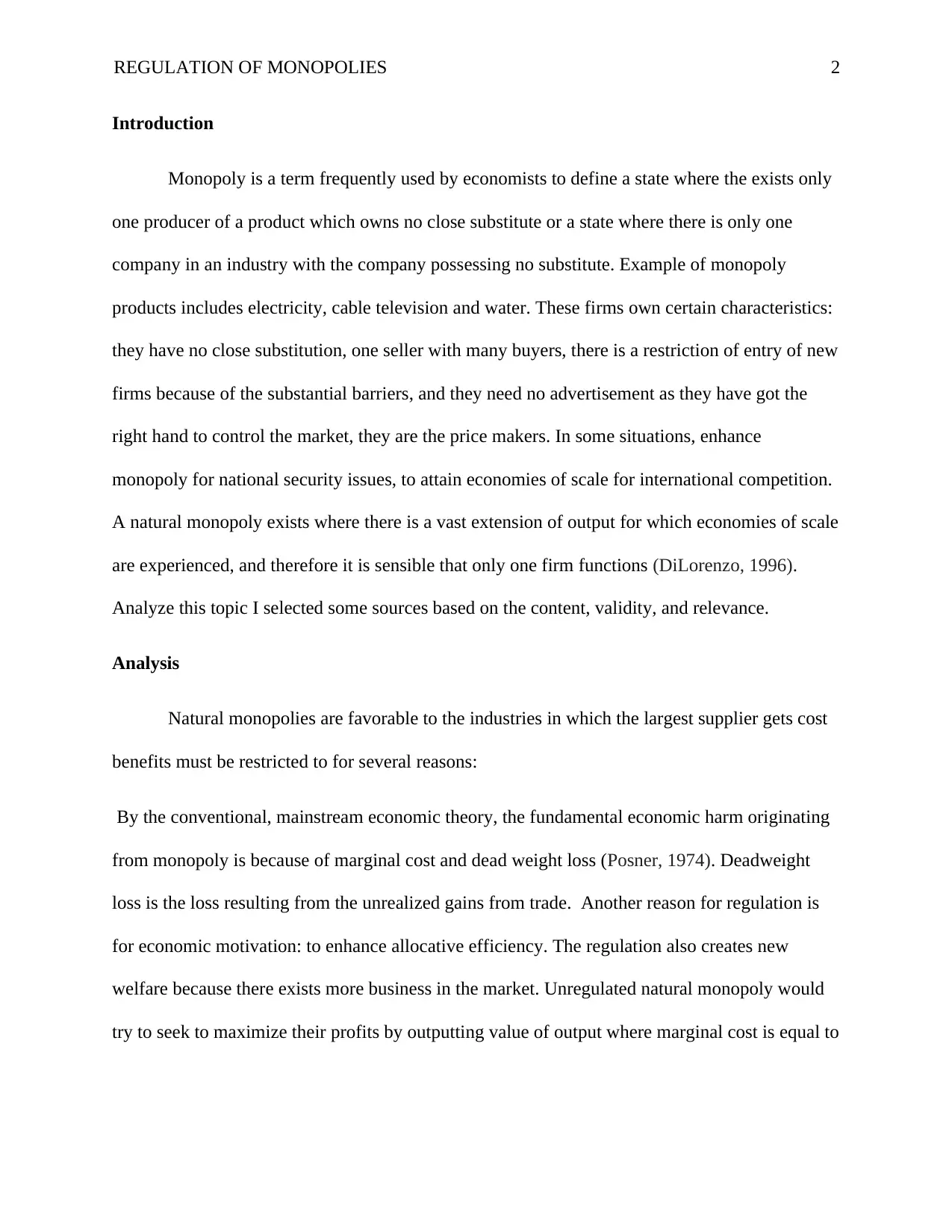
REGULATION OF MONOPOLIES 2
Introduction
Monopoly is a term frequently used by economists to define a state where the exists only
one producer of a product which owns no close substitute or a state where there is only one
company in an industry with the company possessing no substitute. Example of monopoly
products includes electricity, cable television and water. These firms own certain characteristics:
they have no close substitution, one seller with many buyers, there is a restriction of entry of new
firms because of the substantial barriers, and they need no advertisement as they have got the
right hand to control the market, they are the price makers. In some situations, enhance
monopoly for national security issues, to attain economies of scale for international competition.
A natural monopoly exists where there is a vast extension of output for which economies of scale
are experienced, and therefore it is sensible that only one firm functions (DiLorenzo, 1996).
Analyze this topic I selected some sources based on the content, validity, and relevance.
Analysis
Natural monopolies are favorable to the industries in which the largest supplier gets cost
benefits must be restricted to for several reasons:
By the conventional, mainstream economic theory, the fundamental economic harm originating
from monopoly is because of marginal cost and dead weight loss (Posner, 1974). Deadweight
loss is the loss resulting from the unrealized gains from trade. Another reason for regulation is
for economic motivation: to enhance allocative efficiency. The regulation also creates new
welfare because there exists more business in the market. Unregulated natural monopoly would
try to seek to maximize their profits by outputting value of output where marginal cost is equal to
Introduction
Monopoly is a term frequently used by economists to define a state where the exists only
one producer of a product which owns no close substitute or a state where there is only one
company in an industry with the company possessing no substitute. Example of monopoly
products includes electricity, cable television and water. These firms own certain characteristics:
they have no close substitution, one seller with many buyers, there is a restriction of entry of new
firms because of the substantial barriers, and they need no advertisement as they have got the
right hand to control the market, they are the price makers. In some situations, enhance
monopoly for national security issues, to attain economies of scale for international competition.
A natural monopoly exists where there is a vast extension of output for which economies of scale
are experienced, and therefore it is sensible that only one firm functions (DiLorenzo, 1996).
Analyze this topic I selected some sources based on the content, validity, and relevance.
Analysis
Natural monopolies are favorable to the industries in which the largest supplier gets cost
benefits must be restricted to for several reasons:
By the conventional, mainstream economic theory, the fundamental economic harm originating
from monopoly is because of marginal cost and dead weight loss (Posner, 1974). Deadweight
loss is the loss resulting from the unrealized gains from trade. Another reason for regulation is
for economic motivation: to enhance allocative efficiency. The regulation also creates new
welfare because there exists more business in the market. Unregulated natural monopoly would
try to seek to maximize their profits by outputting value of output where marginal cost is equal to
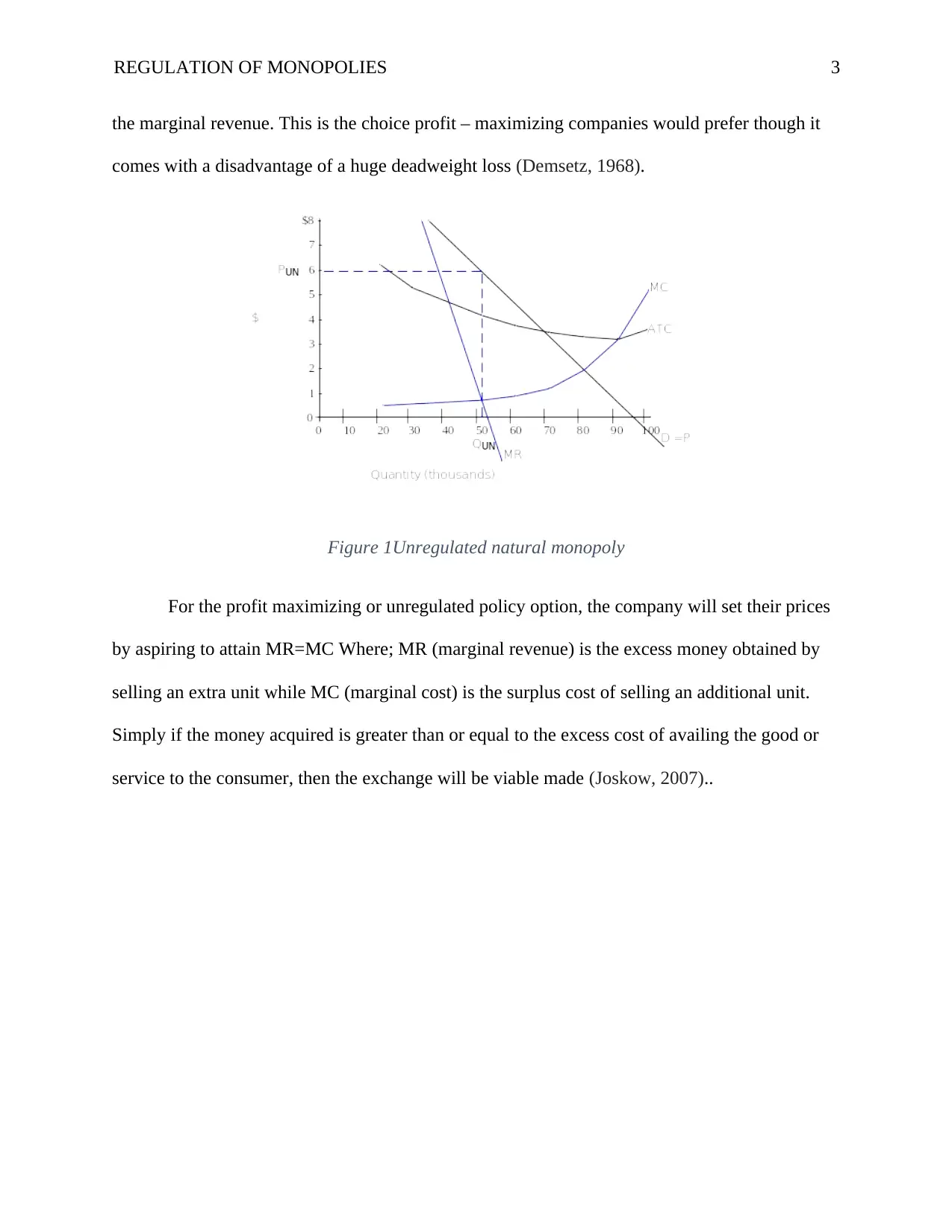
REGULATION OF MONOPOLIES 3
the marginal revenue. This is the choice profit – maximizing companies would prefer though it
comes with a disadvantage of a huge deadweight loss (Demsetz, 1968).
Figure 1Unregulated natural monopoly
For the profit maximizing or unregulated policy option, the company will set their prices
by aspiring to attain MR=MC Where; MR (marginal revenue) is the excess money obtained by
selling an extra unit while MC (marginal cost) is the surplus cost of selling an additional unit.
Simply if the money acquired is greater than or equal to the excess cost of availing the good or
service to the consumer, then the exchange will be viable made (Joskow, 2007)..
the marginal revenue. This is the choice profit – maximizing companies would prefer though it
comes with a disadvantage of a huge deadweight loss (Demsetz, 1968).
Figure 1Unregulated natural monopoly
For the profit maximizing or unregulated policy option, the company will set their prices
by aspiring to attain MR=MC Where; MR (marginal revenue) is the excess money obtained by
selling an extra unit while MC (marginal cost) is the surplus cost of selling an additional unit.
Simply if the money acquired is greater than or equal to the excess cost of availing the good or
service to the consumer, then the exchange will be viable made (Joskow, 2007)..
⊘ This is a preview!⊘
Do you want full access?
Subscribe today to unlock all pages.

Trusted by 1+ million students worldwide
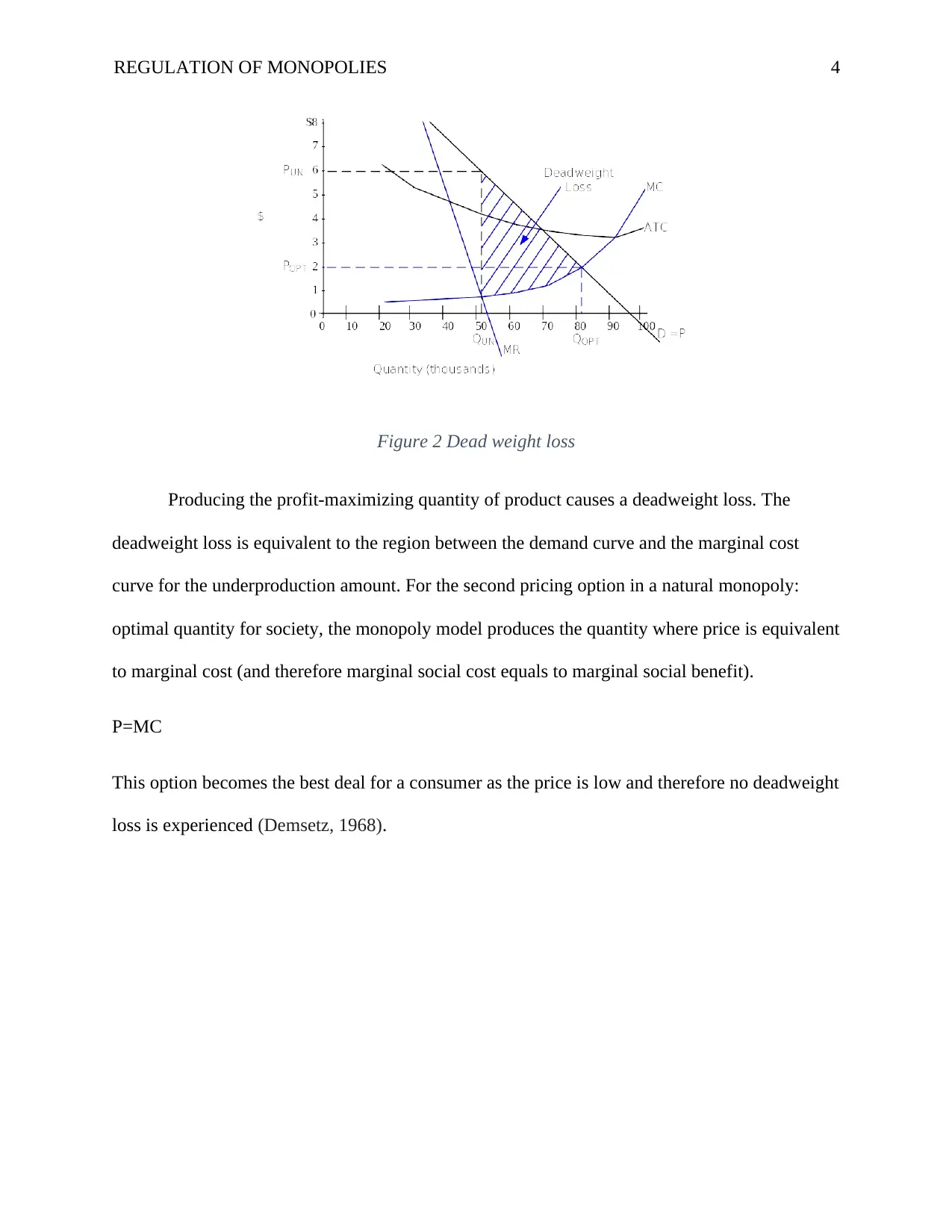
REGULATION OF MONOPOLIES 4
Figure 2 Dead weight loss
Producing the profit-maximizing quantity of product causes a deadweight loss. The
deadweight loss is equivalent to the region between the demand curve and the marginal cost
curve for the underproduction amount. For the second pricing option in a natural monopoly:
optimal quantity for society, the monopoly model produces the quantity where price is equivalent
to marginal cost (and therefore marginal social cost equals to marginal social benefit).
P=MC
This option becomes the best deal for a consumer as the price is low and therefore no deadweight
loss is experienced (Demsetz, 1968).
Figure 2 Dead weight loss
Producing the profit-maximizing quantity of product causes a deadweight loss. The
deadweight loss is equivalent to the region between the demand curve and the marginal cost
curve for the underproduction amount. For the second pricing option in a natural monopoly:
optimal quantity for society, the monopoly model produces the quantity where price is equivalent
to marginal cost (and therefore marginal social cost equals to marginal social benefit).
P=MC
This option becomes the best deal for a consumer as the price is low and therefore no deadweight
loss is experienced (Demsetz, 1968).
Paraphrase This Document
Need a fresh take? Get an instant paraphrase of this document with our AI Paraphraser
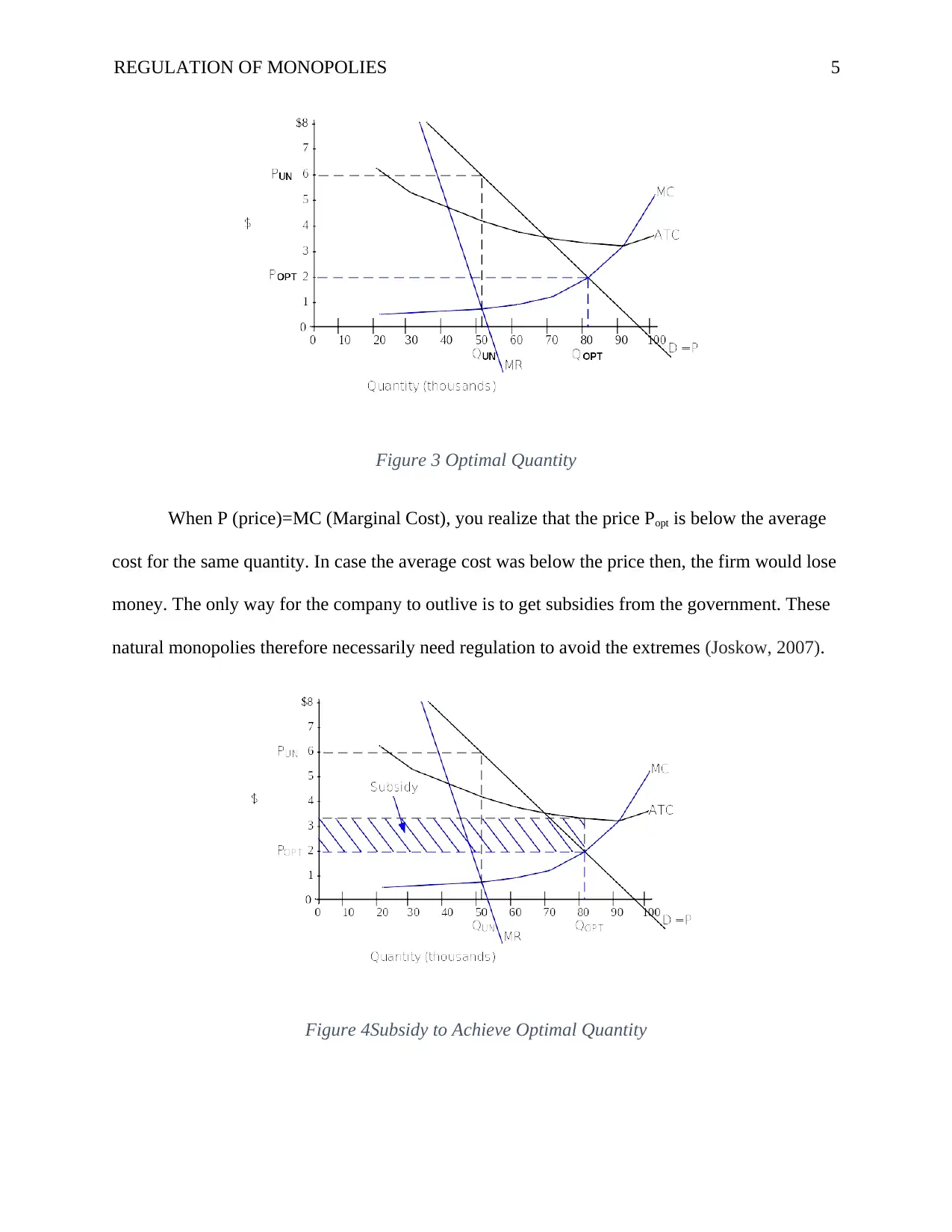
REGULATION OF MONOPOLIES 5
Figure 3 Optimal Quantity
When P (price)=MC (Marginal Cost), you realize that the price Popt is below the average
cost for the same quantity. In case the average cost was below the price then, the firm would lose
money. The only way for the company to outlive is to get subsidies from the government. These
natural monopolies therefore necessarily need regulation to avoid the extremes (Joskow, 2007).
Figure 4Subsidy to Achieve Optimal Quantity
Figure 3 Optimal Quantity
When P (price)=MC (Marginal Cost), you realize that the price Popt is below the average
cost for the same quantity. In case the average cost was below the price then, the firm would lose
money. The only way for the company to outlive is to get subsidies from the government. These
natural monopolies therefore necessarily need regulation to avoid the extremes (Joskow, 2007).
Figure 4Subsidy to Achieve Optimal Quantity
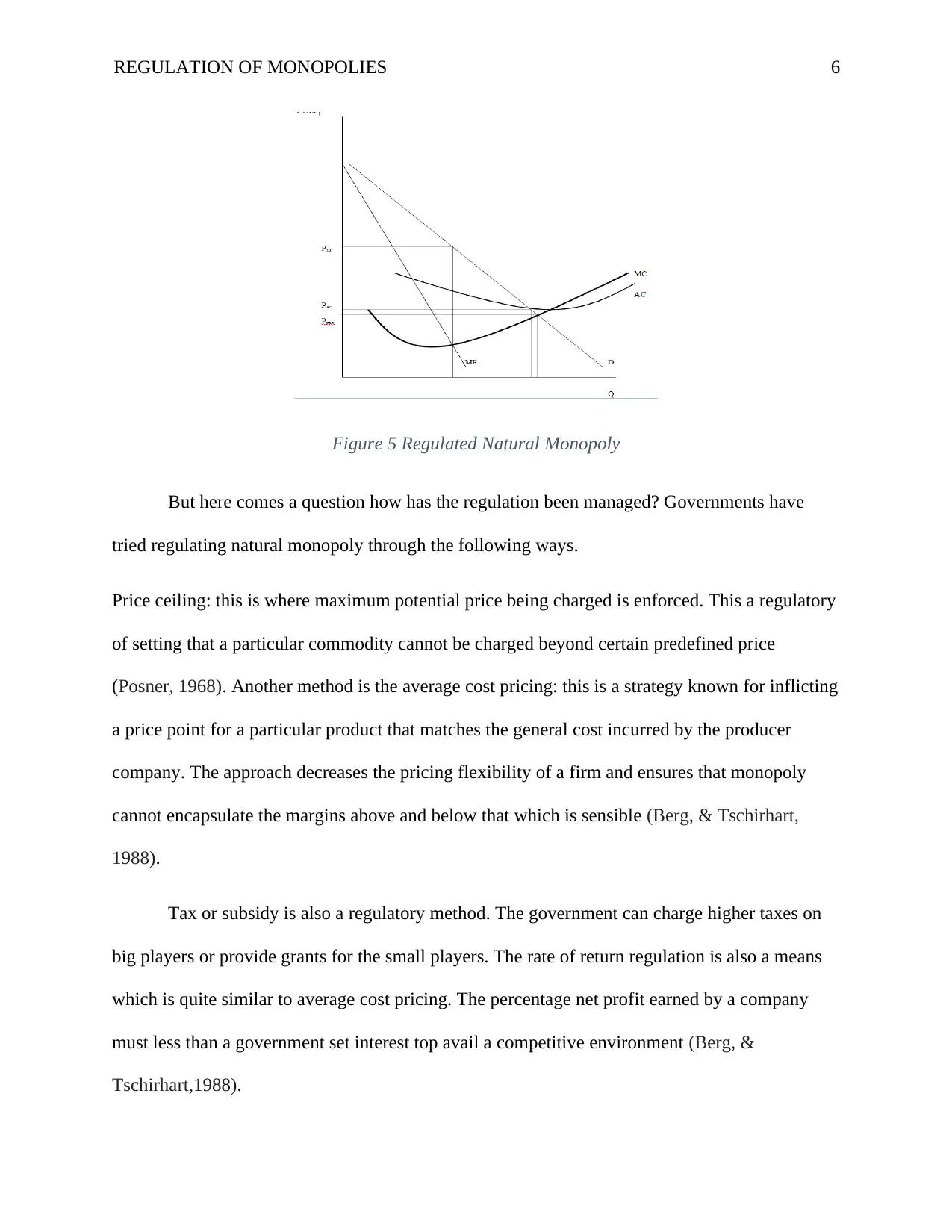
REGULATION OF MONOPOLIES 6
Figure 5 Regulated Natural Monopoly
But here comes a question how has the regulation been managed? Governments have
tried regulating natural monopoly through the following ways.
Price ceiling: this is where maximum potential price being charged is enforced. This a regulatory
of setting that a particular commodity cannot be charged beyond certain predefined price
(Posner, 1968). Another method is the average cost pricing: this is a strategy known for inflicting
a price point for a particular product that matches the general cost incurred by the producer
company. The approach decreases the pricing flexibility of a firm and ensures that monopoly
cannot encapsulate the margins above and below that which is sensible (Berg, & Tschirhart,
1988).
Tax or subsidy is also a regulatory method. The government can charge higher taxes on
big players or provide grants for the small players. The rate of return regulation is also a means
which is quite similar to average cost pricing. The percentage net profit earned by a company
must less than a government set interest top avail a competitive environment (Berg, &
Tschirhart,1988).
Figure 5 Regulated Natural Monopoly
But here comes a question how has the regulation been managed? Governments have
tried regulating natural monopoly through the following ways.
Price ceiling: this is where maximum potential price being charged is enforced. This a regulatory
of setting that a particular commodity cannot be charged beyond certain predefined price
(Posner, 1968). Another method is the average cost pricing: this is a strategy known for inflicting
a price point for a particular product that matches the general cost incurred by the producer
company. The approach decreases the pricing flexibility of a firm and ensures that monopoly
cannot encapsulate the margins above and below that which is sensible (Berg, & Tschirhart,
1988).
Tax or subsidy is also a regulatory method. The government can charge higher taxes on
big players or provide grants for the small players. The rate of return regulation is also a means
which is quite similar to average cost pricing. The percentage net profit earned by a company
must less than a government set interest top avail a competitive environment (Berg, &
Tschirhart,1988).
⊘ This is a preview!⊘
Do you want full access?
Subscribe today to unlock all pages.

Trusted by 1+ million students worldwide
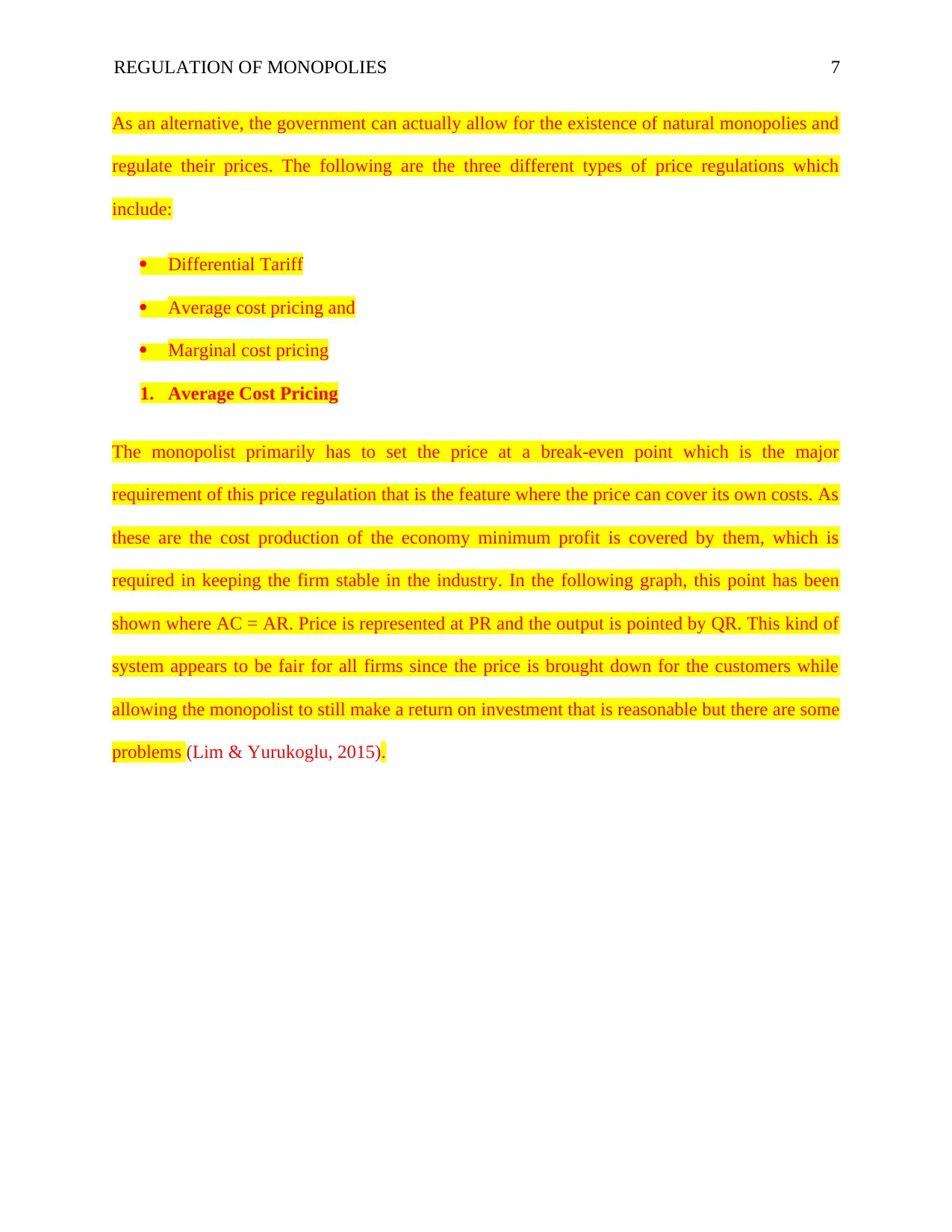
REGULATION OF MONOPOLIES 7
As an alternative, the government can actually allow for the existence of natural monopolies and
regulate their prices. The following are the three different types of price regulations which
include:
Differential Tariff
Average cost pricing and
Marginal cost pricing
1. Average Cost Pricing
The monopolist primarily has to set the price at a break-even point which is the major
requirement of this price regulation that is the feature where the price can cover its own costs. As
these are the cost production of the economy minimum profit is covered by them, which is
required in keeping the firm stable in the industry. In the following graph, this point has been
shown where AC = AR. Price is represented at PR and the output is pointed by QR. This kind of
system appears to be fair for all firms since the price is brought down for the customers while
allowing the monopolist to still make a return on investment that is reasonable but there are some
problems (Lim & Yurukoglu, 2015).
As an alternative, the government can actually allow for the existence of natural monopolies and
regulate their prices. The following are the three different types of price regulations which
include:
Differential Tariff
Average cost pricing and
Marginal cost pricing
1. Average Cost Pricing
The monopolist primarily has to set the price at a break-even point which is the major
requirement of this price regulation that is the feature where the price can cover its own costs. As
these are the cost production of the economy minimum profit is covered by them, which is
required in keeping the firm stable in the industry. In the following graph, this point has been
shown where AC = AR. Price is represented at PR and the output is pointed by QR. This kind of
system appears to be fair for all firms since the price is brought down for the customers while
allowing the monopolist to still make a return on investment that is reasonable but there are some
problems (Lim & Yurukoglu, 2015).
Paraphrase This Document
Need a fresh take? Get an instant paraphrase of this document with our AI Paraphraser
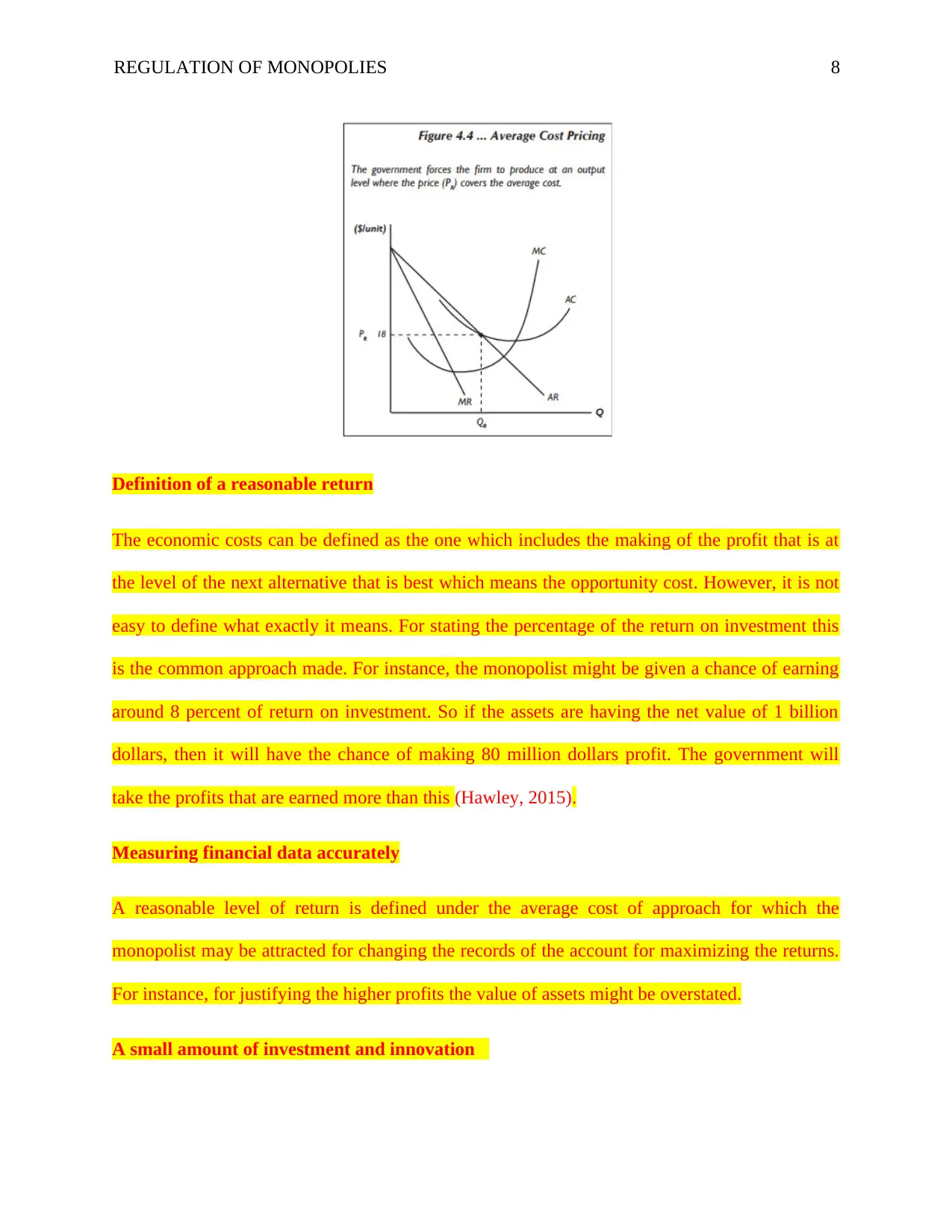
REGULATION OF MONOPOLIES 8
Definition of a reasonable return
The economic costs can be defined as the one which includes the making of the profit that is at
the level of the next alternative that is best which means the opportunity cost. However, it is not
easy to define what exactly it means. For stating the percentage of the return on investment this
is the common approach made. For instance, the monopolist might be given a chance of earning
around 8 percent of return on investment. So if the assets are having the net value of 1 billion
dollars, then it will have the chance of making 80 million dollars profit. The government will
take the profits that are earned more than this (Hawley, 2015).
Measuring financial data accurately
A reasonable level of return is defined under the average cost of approach for which the
monopolist may be attracted for changing the records of the account for maximizing the returns.
For instance, for justifying the higher profits the value of assets might be overstated.
A small amount of investment and innovation
Definition of a reasonable return
The economic costs can be defined as the one which includes the making of the profit that is at
the level of the next alternative that is best which means the opportunity cost. However, it is not
easy to define what exactly it means. For stating the percentage of the return on investment this
is the common approach made. For instance, the monopolist might be given a chance of earning
around 8 percent of return on investment. So if the assets are having the net value of 1 billion
dollars, then it will have the chance of making 80 million dollars profit. The government will
take the profits that are earned more than this (Hawley, 2015).
Measuring financial data accurately
A reasonable level of return is defined under the average cost of approach for which the
monopolist may be attracted for changing the records of the account for maximizing the returns.
For instance, for justifying the higher profits the value of assets might be overstated.
A small amount of investment and innovation
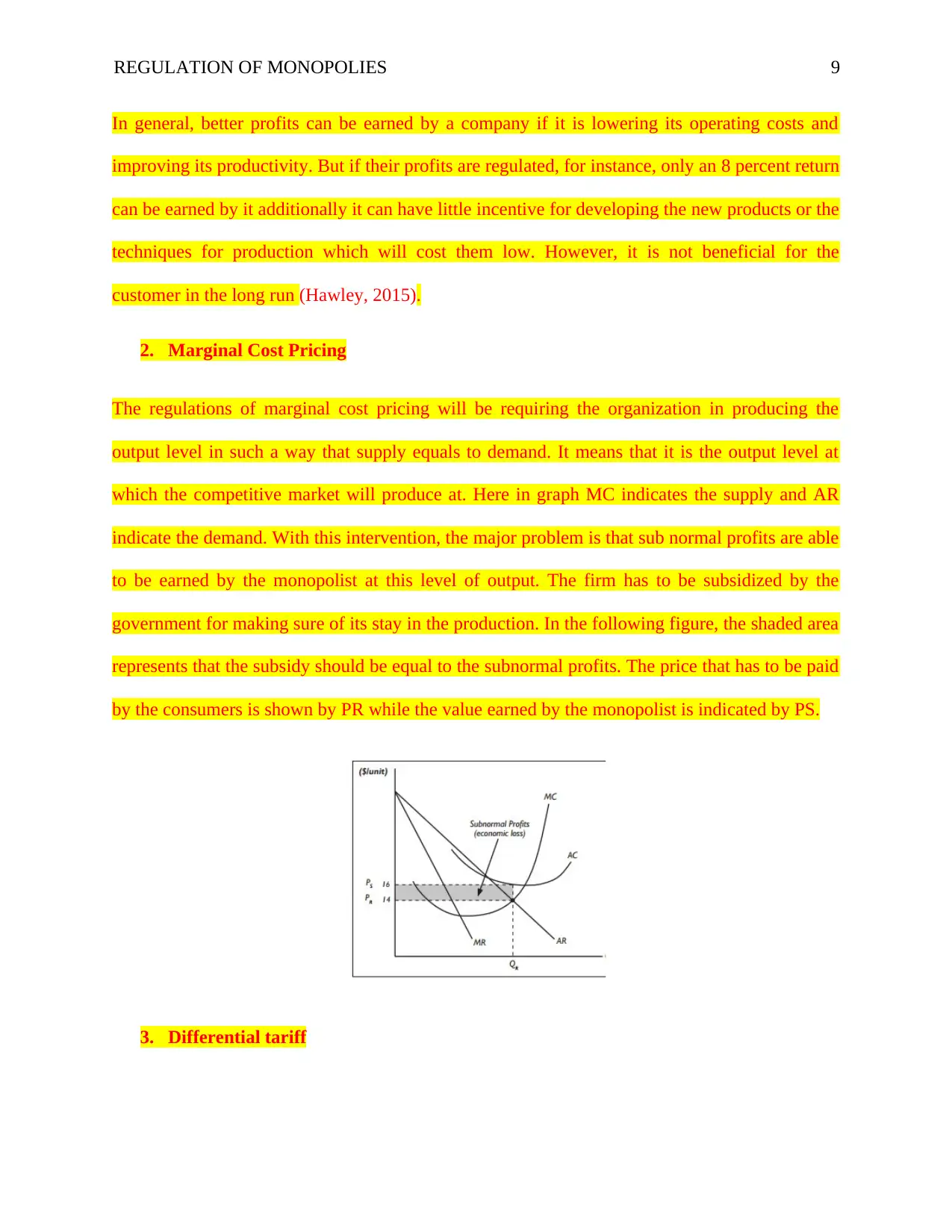
REGULATION OF MONOPOLIES 9
In general, better profits can be earned by a company if it is lowering its operating costs and
improving its productivity. But if their profits are regulated, for instance, only an 8 percent return
can be earned by it additionally it can have little incentive for developing the new products or the
techniques for production which will cost them low. However, it is not beneficial for the
customer in the long run (Hawley, 2015).
2. Marginal Cost Pricing
The regulations of marginal cost pricing will be requiring the organization in producing the
output level in such a way that supply equals to demand. It means that it is the output level at
which the competitive market will produce at. Here in graph MC indicates the supply and AR
indicate the demand. With this intervention, the major problem is that sub normal profits are able
to be earned by the monopolist at this level of output. The firm has to be subsidized by the
government for making sure of its stay in the production. In the following figure, the shaded area
represents that the subsidy should be equal to the subnormal profits. The price that has to be paid
by the consumers is shown by PR while the value earned by the monopolist is indicated by PS.
3. Differential tariff
In general, better profits can be earned by a company if it is lowering its operating costs and
improving its productivity. But if their profits are regulated, for instance, only an 8 percent return
can be earned by it additionally it can have little incentive for developing the new products or the
techniques for production which will cost them low. However, it is not beneficial for the
customer in the long run (Hawley, 2015).
2. Marginal Cost Pricing
The regulations of marginal cost pricing will be requiring the organization in producing the
output level in such a way that supply equals to demand. It means that it is the output level at
which the competitive market will produce at. Here in graph MC indicates the supply and AR
indicate the demand. With this intervention, the major problem is that sub normal profits are able
to be earned by the monopolist at this level of output. The firm has to be subsidized by the
government for making sure of its stay in the production. In the following figure, the shaded area
represents that the subsidy should be equal to the subnormal profits. The price that has to be paid
by the consumers is shown by PR while the value earned by the monopolist is indicated by PS.
3. Differential tariff
⊘ This is a preview!⊘
Do you want full access?
Subscribe today to unlock all pages.

Trusted by 1+ million students worldwide
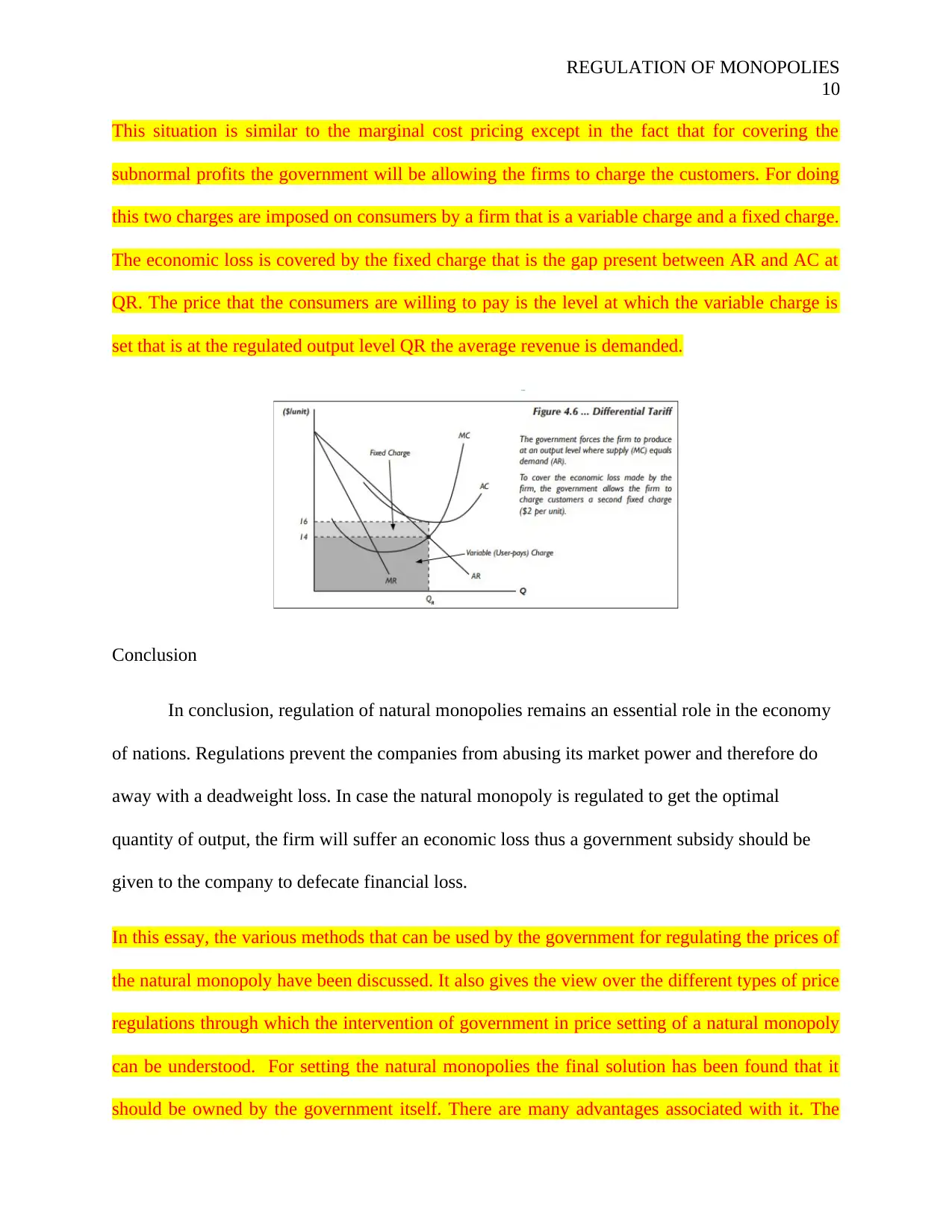
REGULATION OF MONOPOLIES
10
This situation is similar to the marginal cost pricing except in the fact that for covering the
subnormal profits the government will be allowing the firms to charge the customers. For doing
this two charges are imposed on consumers by a firm that is a variable charge and a fixed charge.
The economic loss is covered by the fixed charge that is the gap present between AR and AC at
QR. The price that the consumers are willing to pay is the level at which the variable charge is
set that is at the regulated output level QR the average revenue is demanded.
Conclusion
In conclusion, regulation of natural monopolies remains an essential role in the economy
of nations. Regulations prevent the companies from abusing its market power and therefore do
away with a deadweight loss. In case the natural monopoly is regulated to get the optimal
quantity of output, the firm will suffer an economic loss thus a government subsidy should be
given to the company to defecate financial loss.
In this essay, the various methods that can be used by the government for regulating the prices of
the natural monopoly have been discussed. It also gives the view over the different types of price
regulations through which the intervention of government in price setting of a natural monopoly
can be understood. For setting the natural monopolies the final solution has been found that it
should be owned by the government itself. There are many advantages associated with it. The
10
This situation is similar to the marginal cost pricing except in the fact that for covering the
subnormal profits the government will be allowing the firms to charge the customers. For doing
this two charges are imposed on consumers by a firm that is a variable charge and a fixed charge.
The economic loss is covered by the fixed charge that is the gap present between AR and AC at
QR. The price that the consumers are willing to pay is the level at which the variable charge is
set that is at the regulated output level QR the average revenue is demanded.
Conclusion
In conclusion, regulation of natural monopolies remains an essential role in the economy
of nations. Regulations prevent the companies from abusing its market power and therefore do
away with a deadweight loss. In case the natural monopoly is regulated to get the optimal
quantity of output, the firm will suffer an economic loss thus a government subsidy should be
given to the company to defecate financial loss.
In this essay, the various methods that can be used by the government for regulating the prices of
the natural monopoly have been discussed. It also gives the view over the different types of price
regulations through which the intervention of government in price setting of a natural monopoly
can be understood. For setting the natural monopolies the final solution has been found that it
should be owned by the government itself. There are many advantages associated with it. The
Paraphrase This Document
Need a fresh take? Get an instant paraphrase of this document with our AI Paraphraser
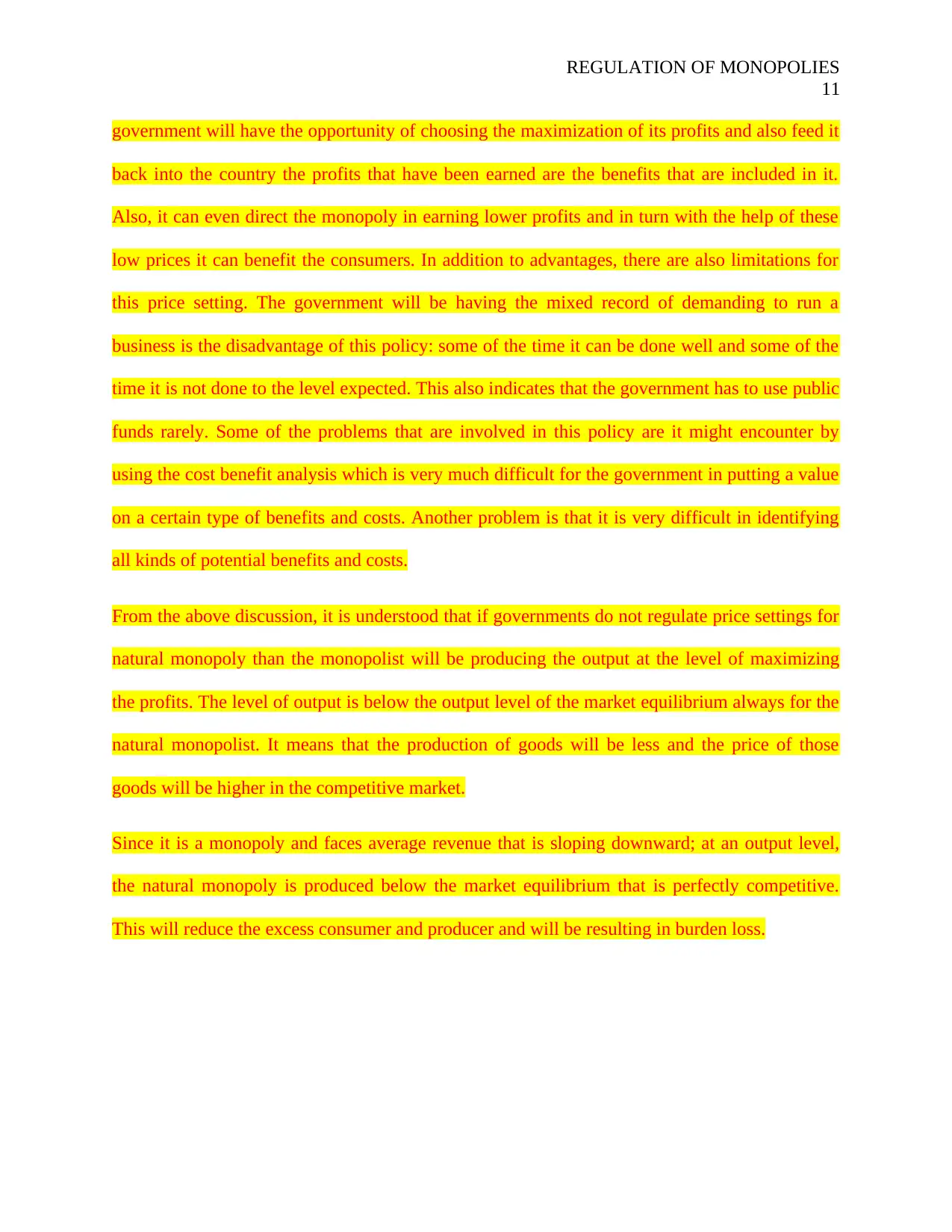
REGULATION OF MONOPOLIES
11
government will have the opportunity of choosing the maximization of its profits and also feed it
back into the country the profits that have been earned are the benefits that are included in it.
Also, it can even direct the monopoly in earning lower profits and in turn with the help of these
low prices it can benefit the consumers. In addition to advantages, there are also limitations for
this price setting. The government will be having the mixed record of demanding to run a
business is the disadvantage of this policy: some of the time it can be done well and some of the
time it is not done to the level expected. This also indicates that the government has to use public
funds rarely. Some of the problems that are involved in this policy are it might encounter by
using the cost benefit analysis which is very much difficult for the government in putting a value
on a certain type of benefits and costs. Another problem is that it is very difficult in identifying
all kinds of potential benefits and costs.
From the above discussion, it is understood that if governments do not regulate price settings for
natural monopoly than the monopolist will be producing the output at the level of maximizing
the profits. The level of output is below the output level of the market equilibrium always for the
natural monopolist. It means that the production of goods will be less and the price of those
goods will be higher in the competitive market.
Since it is a monopoly and faces average revenue that is sloping downward; at an output level,
the natural monopoly is produced below the market equilibrium that is perfectly competitive.
This will reduce the excess consumer and producer and will be resulting in burden loss.
11
government will have the opportunity of choosing the maximization of its profits and also feed it
back into the country the profits that have been earned are the benefits that are included in it.
Also, it can even direct the monopoly in earning lower profits and in turn with the help of these
low prices it can benefit the consumers. In addition to advantages, there are also limitations for
this price setting. The government will be having the mixed record of demanding to run a
business is the disadvantage of this policy: some of the time it can be done well and some of the
time it is not done to the level expected. This also indicates that the government has to use public
funds rarely. Some of the problems that are involved in this policy are it might encounter by
using the cost benefit analysis which is very much difficult for the government in putting a value
on a certain type of benefits and costs. Another problem is that it is very difficult in identifying
all kinds of potential benefits and costs.
From the above discussion, it is understood that if governments do not regulate price settings for
natural monopoly than the monopolist will be producing the output at the level of maximizing
the profits. The level of output is below the output level of the market equilibrium always for the
natural monopolist. It means that the production of goods will be less and the price of those
goods will be higher in the competitive market.
Since it is a monopoly and faces average revenue that is sloping downward; at an output level,
the natural monopoly is produced below the market equilibrium that is perfectly competitive.
This will reduce the excess consumer and producer and will be resulting in burden loss.
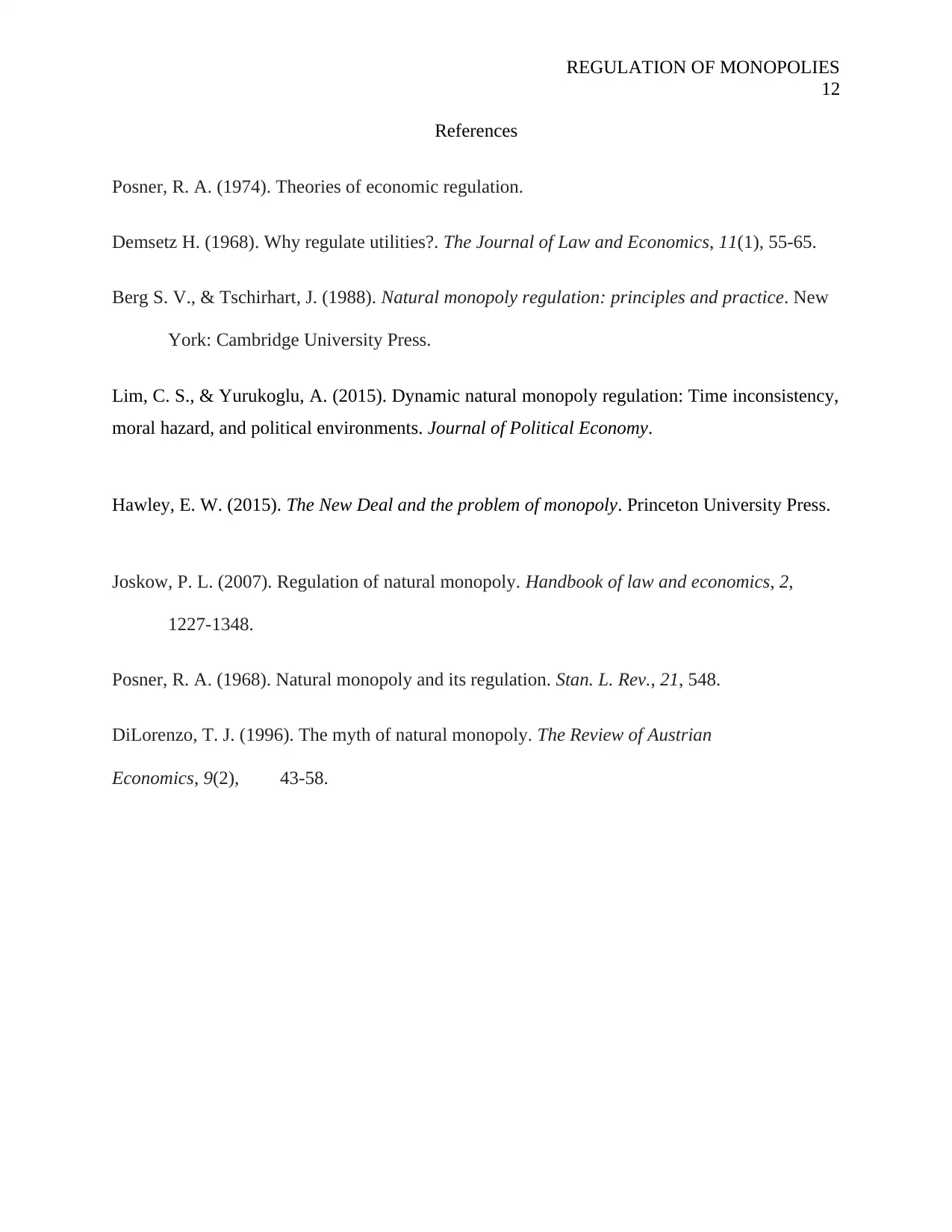
REGULATION OF MONOPOLIES
12
References
Posner, R. A. (1974). Theories of economic regulation.
Demsetz H. (1968). Why regulate utilities?. The Journal of Law and Economics, 11(1), 55-65.
Berg S. V., & Tschirhart, J. (1988). Natural monopoly regulation: principles and practice. New
York: Cambridge University Press.
Lim, C. S., & Yurukoglu, A. (2015). Dynamic natural monopoly regulation: Time inconsistency,
moral hazard, and political environments. Journal of Political Economy.
Hawley, E. W. (2015). The New Deal and the problem of monopoly. Princeton University Press.
Joskow, P. L. (2007). Regulation of natural monopoly. Handbook of law and economics, 2,
1227-1348.
Posner, R. A. (1968). Natural monopoly and its regulation. Stan. L. Rev., 21, 548.
DiLorenzo, T. J. (1996). The myth of natural monopoly. The Review of Austrian
Economics, 9(2), 43-58.
12
References
Posner, R. A. (1974). Theories of economic regulation.
Demsetz H. (1968). Why regulate utilities?. The Journal of Law and Economics, 11(1), 55-65.
Berg S. V., & Tschirhart, J. (1988). Natural monopoly regulation: principles and practice. New
York: Cambridge University Press.
Lim, C. S., & Yurukoglu, A. (2015). Dynamic natural monopoly regulation: Time inconsistency,
moral hazard, and political environments. Journal of Political Economy.
Hawley, E. W. (2015). The New Deal and the problem of monopoly. Princeton University Press.
Joskow, P. L. (2007). Regulation of natural monopoly. Handbook of law and economics, 2,
1227-1348.
Posner, R. A. (1968). Natural monopoly and its regulation. Stan. L. Rev., 21, 548.
DiLorenzo, T. J. (1996). The myth of natural monopoly. The Review of Austrian
Economics, 9(2), 43-58.
⊘ This is a preview!⊘
Do you want full access?
Subscribe today to unlock all pages.

Trusted by 1+ million students worldwide
1 out of 12
Related Documents
Your All-in-One AI-Powered Toolkit for Academic Success.
+13062052269
info@desklib.com
Available 24*7 on WhatsApp / Email
![[object Object]](/_next/static/media/star-bottom.7253800d.svg)
Unlock your academic potential
Copyright © 2020–2025 A2Z Services. All Rights Reserved. Developed and managed by ZUCOL.





